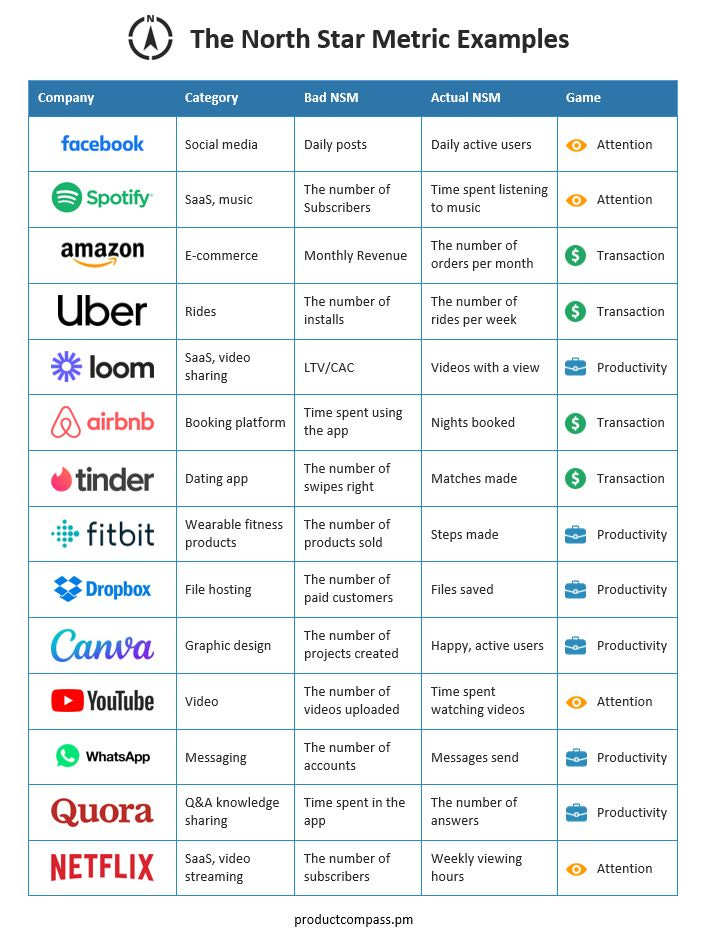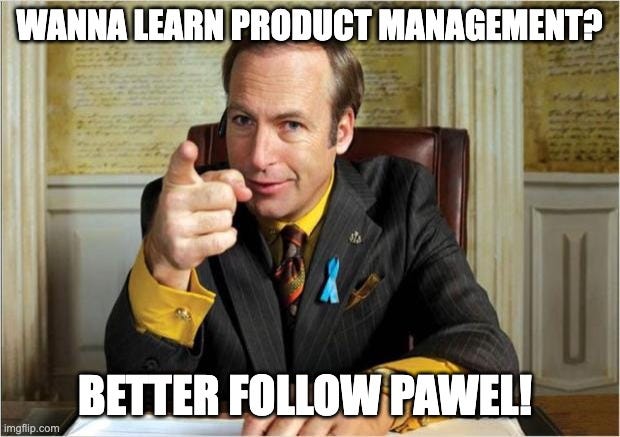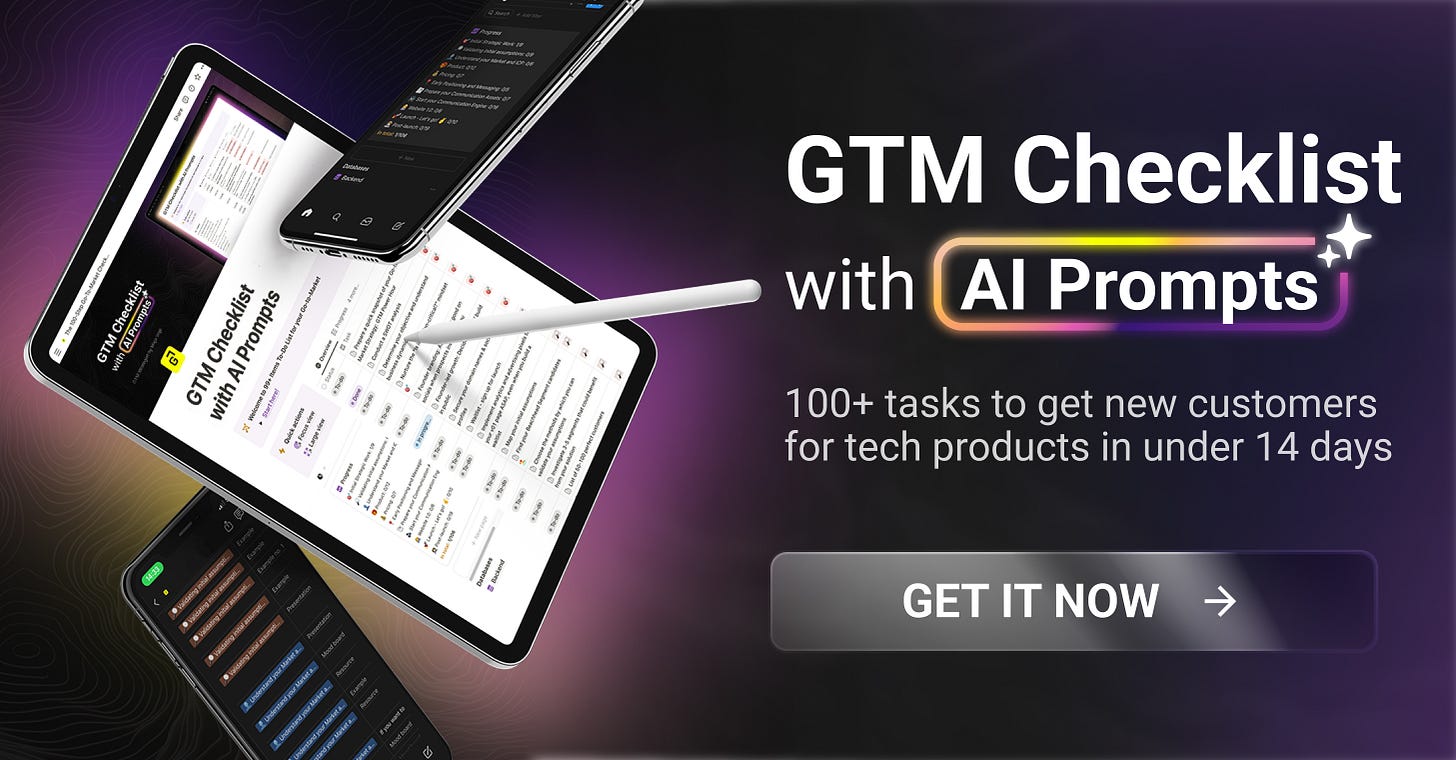7 Free Tools from Product Management Toolbox to Drive 10x Impact on Your Business
Boost Your Business: 7 Free PM Tools for 10x Results
Dear GTM Strategist!
It is no secret that I have learned more useful stuff from Product Managers than from my native Growth background when I was writing the Go-To-Market Strategist book.
Meeting knowledgeable product leaders (all of them very super kind and helpful) has added so much value to developing the GTM Strategist method we use today to get profitable traction fast. And today, we celebrate their contribution to GTM.
Meet one of my favorite people in the product space,
. In my view, Paweł is like a superstar to PMs. He shares insights and resources with nearly 100K readers of the Substack The Product Compass and 200K LinkedIn community.A while back, we teamed up to bring 5 GTM Principles that are mission-critical for PMs to his audience.
Now, I convinced Paweł (it took me 5 months, but we are here 🤠) to share product management frameworks, mental models, and templates from the product management treasury that are mission-critical for us to understand.
Paweł was more than generous.
Buckle up for a value-packed post. In this Substack article, you will get:
Insights into 7 mission-critical frameworks for your GTM
Implementation guides how to use it from a Senior PM
A treasury of visual assets for your presentations, workshops and reports
This newsletter is sponsored by Attio.
Most CRMs were built for yesterday's businesses. Attio is built for what's next.
Attio is an AI-native CRM built specifically for the next era of companies. It’s flexible, easily configures to your unique data structures, and adapts to any business model - taking you scale from seed stage to category leader.
With Attio, your powerful CRM builds itself in minutes through automatic data sync and enrichment. Then unleash the full power of the platform - from AI-powered automations that handle even your most complex business processes, to our research agent that can help with prospecting and lead routing at scale.
Join industry leaders like Flatfile, Replicate, Modal and more.
Try the CRM that’s built for the future. Start a free Attio trial today.
Paweł, the floor is yours 🙇
Without further ado, let’s dive into actionable tips, frameworks, and templates that PMMs can benefit from:
Product Strategy Canvas (#1 Google)
North Star Framework Playbook
12 Sources of Insights in Product Management
Hidden Risks in Product Management
The XYZ Hypothesis
Eight Prioritization Frameworks
Free AI Agents for Product Marketers
1. Product Strategy Canvas (#1 Google)
Product strategy is simple to understand.
But, contrary to common misconceptions, it’s not:
A plan (“We will build X, Y, and Z”).
A goal (“We want to grow by 50% by 2024”).
An ambition (“We want to be the best”).
A business model.
A unique value proposition.
I’d argue that many companies do not have a strategy at all.
A good product strategy:
Defines a vision. Why should your employees get up every day and come to work?
Is a single, integrated set of choices that reinforce each other.
Defines the market and the constraints.
Focuses on customers whom you can’t control.
Has a theory on how to persuade them to do what you want.
Explains the competencies, resources, and systems you need.
Enables you to say no instead of chasing every shiny opportunity.
Can’t be copied. This is essential. The moment you succeed, someone else will try to do the same.
Allows you to formulate hypotheses.
I couldn't find a single product strategy canvas I could recommend.
So, I created a new one based primarily on the insights of industry experts Michael Porter and Roger Martin. It ranks #1 in Google:
Here, you can learn more. No paywall:
Startup Canvas (for new products) vs. alternatives
2. North Star Framework Playbook
The North Star Metric is a powerful, simple concept every Product Manager and Product Marketing Manager should know. But it’s often misunderstood.
What is a North Star Metric?
The term has been popularized by
(Sean’s Substack), also known for coining "growth hacking" while being a growth marketer at Dropbox.In the Growth Hacking world, North Star Metric:
Is a single metric. The goal is to create focus.
Is easy to understand, enabling everyone to speak the same language.
Is customer-centric. Reflects how customers get value from the product.
Ideally, it ensures the value is sustainable, typically by forming habits.
Represents progress toward vision/mission.
Is quantitative. It relies on numbers, not opinions.
Is actionable. You take action based on how it changes.
Serves as a leading indicator of your long-term business success.
Common Misconceptions
It's important to clarify what the North Star Metric is not:
A few metrics. While a company may select a few key metrics, referring to them as "North Star Metrics" is a misunderstanding. At the same time, a single North Star Metric is often accompanied by a set of "input metrics."
A metric focused on business value, like LTV/CAC. It misses the essence of customer-centricity. Besides, can your team truly get excited about just increasing revenue?
A strategy. A strategy is a cohesive set of choices, such as a Value Proposition, that reinforce one another and help you to succeed in the selected market. Your NSM must align with your strategy. And it's one of the strategic choices.
Recommended Classification
I've come across various attempts to classify North Star Metrics. The best one I've found was proposed by Amplitude. Depending on the game you are playing, you want to focus on:
Attention: How much time do your customers want to spend using your product? The time and recurrent use of a product can indicate the value people derive from it.
Transaction: How many transactions do your customers make in your product? Your goal is to help customers find the right product quickly and easily.
Productivity: How efficiently and effectively can someone do their work? Your goal is to help customers with specific tasks.
Identifying the game you are playing is the first step toward finding your North Star Metric.
Free North Star Framework Playbook
I summarized all key insights on the North Start Framework in my free playbook, The North Star Framework 101 (13 pages, PDF).
You can download it for free here:
3. 12 Sources of Insights in Product Management
When working on a product, a common piece of advice is to “just talk to customers.”
Talking to customers regularly is super important for any product team. But the best product teams leverage insights from multiple sources.
Here is my mental framework and 12 ideas you can start using tomorrow:
In particular:
Data and product analytics help you understand what customers do in your product. Customer interviews help you understand why they do it.
Stakeholders (like sales, support, or customer success teams) spend countless hours with customers and can share insights you might not discover otherwise. Ignoring their knowledge and starting discovery from scratch is a common mistake among new product teams.
Feature requests can help you pinpoint underserved needs. Product teams often dismiss them by saying, “customers don’t know what they want.” You don’t have to build everything customers ask for, but these requests can spark valuable discussions. And frankly, some feature requests, like importing files from Google Drive, are no-brainers.
Benchmarking is another valuable tool. While we should not obsess over competitors, studying how others tackle similar challenges can help you validate ideas, avoid pitfalls, and find new opportunities. The key is to learn from competitors without simply copying them.
By pulling insights from multiple sources, you maximize your impact as a PM/PMM.
4. Hidden Risks in Product Management
I’d argue that product management is, at its heart, about managing risks.
We want to identify and test the riskiest assumptions as early as possible to get maximum validated learning with minimum effort.
Product teams usually focus on the well-known framework: Value, Usability, Viability, and Feasibility. Some simplify it to Desirability, Viability, and Feasibility.
But I’ve seen countless products and initiatives fail for different reasons.
Depending on the context, three other critical risk areas to consider.
Risk area 1: Go-to-market
Ask yourself:
Can we market it?
Do we have the required channels?
Can we convince sour customers to try or buy it?
Is this the right messaging for this channel?
Is this the right time?
Is this the right way to launch it?
Risk area 2: Strategy
Ask yourself:
What needs to be true for this strategy or business model to work?
Can we ensure our competitors can’t copy our strategy?
Have we considered external political, economic, legal, technological, and environmental factors?
Risk area 3: Teams
Ask yourself:
How well will the team work together?
Do we have the right people?
Do we have the right tools?
Will the entire team stay with us long enough?
What will happen if someone gets sick?
The Extended Risks Classification
Here, you can download my extended risk classification to help identify possible reasons for failures:
You can read more about managing risks in product management and experiments you can perform using a 30-day trial at the end of this post.
5. The XYZ Hypothesis
One of my favorite pieces of advice for working with new products comes from The Right It by Alberto Savoia. His key insights:
Insight 1: Ask for Skin-in-the-Game
Over 80% of new products fail. Alberto Savoia calls this “the law of market failure”:
“Most new products will fail in the market, even if competently executed.” – Alberto Savoia, The Right It
The main reason? People build things nobody needs. And many of these failures can be avoided.
When it comes to market validation, opinions (“It’s awesome”), encouragements (“Go for it!”), and comments and likes on social media are useless.
Because “It’s much easier to open your mouth than your wallet.”
Your market research must include “Skin-in-the-Game Points,” which Alberto Savoia defines as:

Insight 2: Collect Your Own Data (YODA)
In your market research, don’t rely on data collected by others (Other People's Data, or ODP for short).
The fact that others succeeded with similar ideas doesn't mean you will also succeed. Similarly, the fact that others failed with similar ideas doesn't mean you will fail, too.
A good example is what Tesla did with the Tesla Model 3.
Before 2016, Honda, Ford, and Toyota failed. If Elon Musk relied on their data, he would have never built the Tesla Model 3. But he decided to collect his own data (Your Own Data, YODA for short).
On April 1, 2016, Elon proposed a mass-market, affordable electric car and started collecting orders. In 24 hours, he received more than 115,000 orders. In October 2016, Tesla held close to $700 million in customer deposits.
That’s a lot of skin in the game. $35 billion Skin-in-the-Game points, to be precise. Now, they could go forward with building the first gigafactory.
Insight 3: The XYZ Hypothesis
Many formulate a Market Engagement Hypothesis, which combines the fundamental premise behind their idea and how the market will engage with it.
Unfortunately, those hypotheses often look like this: “Many people will build a fast, electric car at a reasonable price.”
To test the idea, we must “say it with numbers,” for example: “At least 5% of mid-size luxury sedan buyers will buy a Tesla Model 3 in 2019 for $40K or more.”
The basic form of the XYZ hypothesis is “At least X% of Y will do Z,” where:
X% represents the percentage of your target market.
Y represents your target market (e.g., “mid-size luxury sedan buyers”).
Z represents how they will engage with your product.
You can learn more about the XYZ Hypothesis from this video:
In his book, Alberto focuses on market engagement. Other hypotheses, like hypotheses related to feasibility or specific features, might have a different form.
You can learn more about experiments to perform using a 30-day trial at the end of this post.
Insight 4: Test Your Ideas by Pretotyping
Alberto uses the term “pretotyping” to emphasize the importance of testing an idea without building a product, as opposed to building working “prototypes.”
Here, you can download a free PDF with nine basic prototyping techniques:

Bonus: a free e-book (90 pages, PDF/Kindle): Pretotype It by Alberto Savoia.
Another approach to test your product ideas is AI Prototyping. A free step-by-step post with two case studies (no paywall): AI Prototyping: The Ultimate Guide For Product Managers.
6. Eight Prioritization Frameworks
In product, we can’t do everything. And we can’t be everything to everyone.
It’s essential to focus on a few things that actually move the needle.
Here are my eight favorite prioritization frameworks with free templates:
Framework 1: Eisenhower Matrix
Useful for prioritizing tasks. Free template (Miro).
Framework 2: Opportunity Score by Dan Olsen
Useful for prioritizing opportunities (customer needs, pains, desires). See my introduction (PDF) and the official Dan Olsen's template (PPTX).
You can learn more from What Is Product Discovery (no paywall).
Framework 3: Impact vs. Effort (2x2)
Useful for prioritizing tasks and initiatives. Free template (Miro).
Framework 4: Risk vs. Reward
Useful for prioritizing initiatives. Free template (PPTX).
Framework 5: Kano Model
Originally developed to prioritize features. Please remember to prioritize customer needs, not solutions. Free template (Miro).
Framework 6: Weighted Decision
Useful for prioritizing decisions when there are many factors to consider. Free template (XLSX)
Framework 7: (R)ICE Framework
Those frameworks are useful for prioritizing initiatives and ideas, considering not only the value but also the effort and risks. Free ICE template (XLSX) and free RICE template (XLSX).
Framework 8: Assumption Prioritization
A canvas created to help you decide which assumptions to test. Free template (PPTX).
You can learn more from this free post: Assumption Prioritization Canvas: How to Identify And Test The Right Assumptions.
7. Free AI Agents for Product Marketers
Recently, I created a set of free AI Agents for Product Managers and Product Marketers:
PRD Generator: Helps you generate Product Requirement Documents
Product Strategist: Helps you develop a winning product strategy (aligned with point #1)
Assumption Identifier: Helps you identify high-risk assumptions (aligned with point #3)
PM Resume Reviewer: Provides a detailed review of your PM/PMM resume
Product Trio Ideation: Helps you explore diverse product ideas
Coming soon are more agentic capabilities:
Deep Web Research (e.g., competitor analysis, market sizing)
Autonomous, Multi-Step Reasoning (e.g., market research > ideation > assumptions)
Thanks For Reading My Guest Post!
Subscribe to The Product Compass Newsletter to dive deeper:
100+ posts (discovery, metrics, experiments, AI product management)
600+ actionable resources (books, videos, templates, playbooks, and courses)
Including my three courses:
And premium posts, such as:
How to Manage Risks as a Product Manager (deep dive)
As a member of the GTM Community, you get a 30-day trial with full, unrestricted access to my content. This offer is valid until Feb 28, 2025:
No hassle. If you forget to cancel, every subscription has a 30-day money-back guarantee 🙌
A huge shoutout to Maja for building the #1 resource on GTM and creating such an insightful community. I learned a lot from her work, and I’m grateful to be part of this space! ❤️
Wow, isn’t Paweł a fountain of knowledge and insights?
Thank you so much for this collaboration - you are a legend!
Definitely give him a follow & power up your product management knowledge, even if that is not your job title. It is worth the effort because it brings you closer to the product team (easier communication and collaboration) and gives you valuable knowledge and skills for launching your products.
Now let’s get these insights to practice - I will start with the AI agents because I am an AI geek. You?
📘 New to GTM? Learn fundamentals. Get my best-selling GTM Strategist book that helped 9,500+ companies to go to market with confidence - frameworks and online course included.
✅ Need ready-to-use GTM assets and AI prompts? Get the 100-Step GTM Checklist with proven website templates, sales decks, landing pages, outbound sequences, LinkedIn post frameworks, email sequences, and 20+ workshops you can immediately run with your team.
🏅 Are you in charge of GTM and responsible for leading others? Grab the GTM Masterclass (6 hours of training, end-to-end GTM explained on examples, guided workshops) to get your team up and running in no time.
🤝 Want to work together? ⏩ Check out the options and let me know how we can join forces.














Great collab. And I just love the GTM Strategist community. Thanks so much, Maja Voje! 💪☺️
Wow